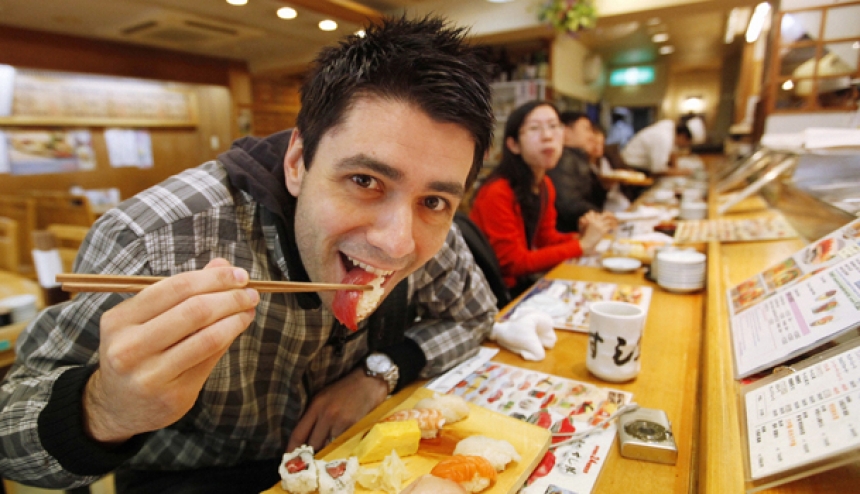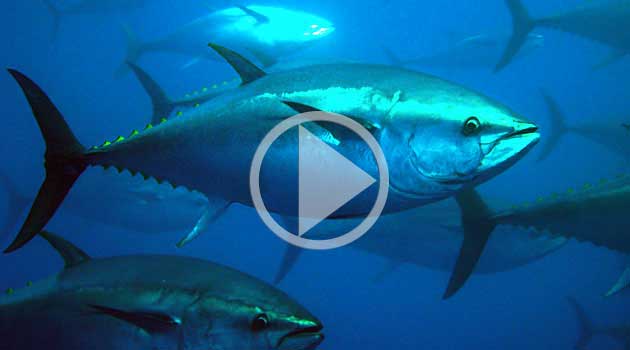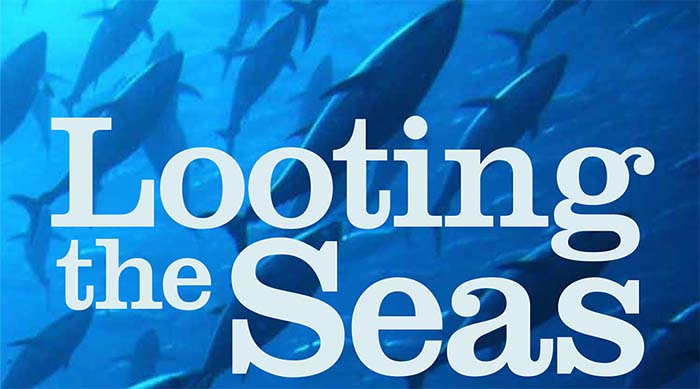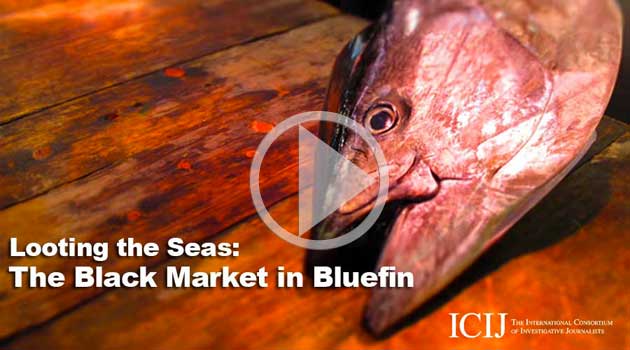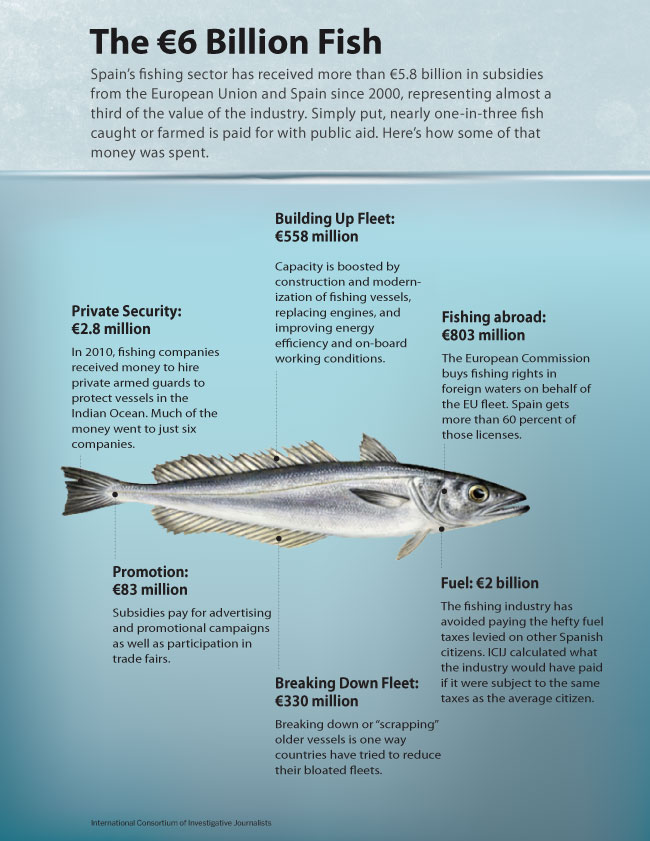Mount Fuji rises across the bay from the 16th century port of Shimizu — a sight fit for a post card. The town has seen better days — its businesses shuttered, fishing boats driven into bankruptcy, and the only department store closed. But the city’s core business — marine and overland trade — has assured its survival. Shimizu is the primary port of landing for tuna in Japan.
Hundreds of tons of tuna arrive here daily from all over the world, but none has the allure of the giant Eastern Atlantic bluefin tuna, a fish that once caught is nurtured for months at sea ranches in the Mediterranean to increase its fat content — and its yen value. Once considered a low-class dish, today the Atlantic bluefin is favored by sushi eaters across Japan.
A single large fish can fetch more than $100,000 at market.
So last year, when Japanese customs decided to stop the importation of more than 3,500 tons of Eastern Atlantic bluefin, the global tuna industry paused for a moment in disbelief. Instead of quickly being trucked to Tokyo’s Tsukiji market and other distribution centers, huge consignments of the bluefin were held in deep-freeze storage warehouses in Shimizu and other cities throughout Japan. The reason: officials suspected the fish were illegally caught.
What’s extraordinary about the case is not so much the potential crimes involved — fraudulent paperwork and fish caught above national quotas — but that the Japanese were finally cracking down on a notoriously off-the-books trade.
For decades Japan has been the final stop of an Eastern Atlantic bluefin tuna supply chain riddled with fraud, criminal misconduct, and lack of oversight. European and North African fleets grossly overfished in the Mediterranean, fattening ranches became centers for the laundering of tuna, and officials from Europe to Japan looked the other way, while stocks of one of the most valued sea creatures were depleted with increasingly little hope of recovery.
The lack of accountability created a massive black market, according to a seven-month inquiry by the International Consortium of Investigative Journalists. More than one out of three Eastern Atlantic bluefin caught between 1998 and 2007 was fished illegally, ICIJ found, feeding an illicit market worth $400 million a year.
During some years, Japan’s bluefin supply exceeded the legal quotas of Eastern Atlantic bluefin tuna by 50 percent, say industry veterans. “When the quota was 21,500 tons, in actual fact about 34,000 tons came to Japan,” said Koji Hayashi, trading manager at Shimizu-based Try Inc., the second largest distributor of frozen bluefin tuna in Japan. So plentiful were the fish, Hayashi recalled, that prices plummeted.
Three-quarters of the world’s bluefin tuna end up in the country’s restaurants, convenience stores and markets, while the rest goes to Europe and the U.S.
Some of Japan’s leading trading houses and seafood companies, led by Mitsubishi Corporation, sit atop well-oiled structures that move the fish from the tuna ranches in the Mediterranean to the Japanese dinner table — an intricate web of wholesalers, brokers, importers, and retailers.
For the Japanese, history may be repeating itself. Just four years ago, an official investigation by Japan and Australia uncovered massive Japanese illegal catches and laundering of southern bluefin tuna, a sister species to the Atlantic bluefin. The investigation was a huge embarrassment for Japan, forcing it to overhaul its fishery management system.
In the Mediterranean, even more drastic reforms will likely be needed, experts say. Earlier this year, Japan led an effort to defeat a proposal to list Eastern Atlantic bluefin tuna under CITES — the Convention on International Trade in Endangered Species — a move that would have banned the bluefin trade. Instead, Japanese officials insist the fishery should continue to be regulated by the Madrid-based International Commission for the Conservation of Atlantic Tunas (ICCAT), a body with 47 member states and the EU that is widely faulted for the dire state of the bluefin stock.
“The stock of bluefin tuna, by far the most valued tuna species, has been so heavily overfished in recent times that its collapse has become a very serious and threatening possibility,” admitted ICCAT Chairman Fabio Hazin at a 2008 meeting of the industry and the commission in Tokyo. “The Commission’s inability to halt the decline of the bluefin tuna stocks for the past years has seriously jeopardized its credibility, raising grave concerns about its actual competence to manage the tuna stocks under its mandate.”
In 2008, Japan supported ICCAT’s efforts to develop a new system to track bluefin from vessel to market, the Bluefin Tuna Catch Document Scheme (BCD). Through this program, each catch gets a unique identifying number that accompanies it through its months-long journey from the vessels to the ranches and to its final destination. Along the way, players must fill out forms and provide timely information on the size of the catch, the vessels and ranches involved, and even the weight of the fish.
In fact, it was irregularities in these documents that raised concerns among Japanese officials about potential illegal shipments in 2009. Information was missing, dates didn’t match, and discrepancies in weight and number of fish suggested that illegalities could have occurred at the ranches. For example, documents showed that some ranches had killed more fattened tuna than they originally took in — an impossibility, given that bluefin do not reproduce in captivity. “We said, ‘This is nonsense!’” stated Masanori Miyahara, Japan’s ICCAT chief delegate, whose colleagues demanded explanations from EU officials about the discrepancies. “If they couldn’t make an explanation as to the legality of the fish, we said, ‘Then don’t bring it to us.’”
ICIJ gained access to the BCD database through an ICCAT member country and found that the data is full of holes, making it nearly impossible for regulators to track the trade from vessel to market as the program originally intended. For example, at least 96 records of bluefin shipments to Japan in 2008 and 2009— equivalent to 5,000 tons — could not be traced back to a ranch or vessel in the database.
Bluefin’s Top Market
Frozen bluefin tuna landing at Shimizu and other ports are trucked at temperatures of minus 55 C to major markets throughout Japan, including Tsukiji — a landmark in central Tokyo and the world’s largest seafood market. More than 450 species of fresh, frozen, and processed seafood are offered on any given day at the market. Fish valued at $5.2 billion flowed through Tsukiji in 2009, according to the Tokyo Metropolitan Government.
With operations leased out to seven wholesalers and more than 700 intermediary wholesalers who deal everything from flowers and chicken eggs to Japanese pickles, the giant, sprawling market can be a busy place. Early morning visitors are likely to take in fast-paced auctions that run via a system of nods, winks, and arcane signs mostly unintelligible to outsiders, while unique turret trucks buzz around a maze of puddle streaked alleys.
Auctions may be the most visible sign of economic activity surrounding tuna, but today nearly all of the frozen and farmed bluefin entering Japan is sold by wholesalers directly to buyers.
Japan’s big trading houses and fishing companies control most of the complex trading structure that moves bluefin from Mediterranean ranches to Tsukiji and other large markets, and from there to food stores and restaurants across Japan. As the Japanese developed a taste for toro, the fatty belly flesh of the bluefin, companies ranging from corporate giants Mitsubishi and Sojitz to seafood traders like Maruha became instrumental to the ranching business that ballooned in the Mediterranean in the mid-1990s. The Japanese teamed up with local partners from Spain to Croatia, financing fishing campaigns in advance, providing technical support, and underwriting loans for ranches.
“They invest in all of that, and in the end they are the bosses,” observed Dalibor Kustura, a Croatian bluefin fisherman referring to Japanese interests in Mediterranean ranches. “They sell fish and everything. They are not owners, but they are owners.”
With Japanese support, ranching dramatically changed the outlook of the bluefin industry in the Mediterranean. Instead of fishing, killing the bluefin and landing it at ports, the fish were towed live — sometimes for months — to sea ranches where they were fattened for as long as a year before being slaughtered and shipped in huge reefer vessels slated for Japan. Ranches spread across the Mediterranean, some in little regulated places like Cyprus, Turkey and Tunisia. With live fish in underwater pens, the ranches proved to be easy places to hide illegally caught bluefin. Indeed, the facilities quickly became a worrisome counterpart to the oversized and out-of-control Mediterranean fleets of purse seining vessels, ships equipped with giant nets capable of catching entire schools of the fish.
Fleets routinely overfished their ICCAT-established quotas, sometimes by 100 percent, and ranches hid what they were doing. The ranches, in effect, “laundered” the extra fish by under-reporting the amount they took in and manipulating fattening ratios to account for the weight of the off-the-books catches, according to interviews with ranchers, inspectors and officials.
Illegalities occurred, fishermen and officials said, because the demand for bluefin in Japan was so huge. “The Japanese needed it. They wanted more and more. Anything,” said a scientist who works closely with the bluefin industry in Croatia.
Japan’s taste for tuna is a rather modern trend. In fact, up until the mid 19th century, the Japanese found the easily spoiled, bloody tuna fish unappealing. Some decades later, exposure to American-style foods during World War II created demand for fattier fish, say historians. But it wasn’t until the 1960s that Atlantic bluefin from North America entered the local market.
“Market anomalies”
As concerns over Eastern Atlantic bluefin mounted in Europe, across the globe, Japanese officials were facing fallout from a similar pattern of illegal fishing in the southern oceans. Sparked by concern from Australia over dwindling stocks, a 2006 investigation commissioned by the Australian and Japanese governments revealed two decades of massive overfishing and laundering of southern bluefin tuna, a sister species to the Atlantic bluefin tuna that swims in the Pacific and Indian oceans.
The findings of the 186-page investigative report, modestly titled Independent Review of Japanese Southern Bluefin Tuna Market Data Anomalies, were so damning that for years the study has been withheld from the public. Names of major wholesalers at Tsukiji were replaced with letters A through E.
ICIJ obtained a copy of the confidential report. It shows that since 1985 Japan’s poor regulation and enforcement allowed a whopping 178,000 metric tons of southern bluefin overcatch to slip through the markets undetected. This off-the-books trade was valued at up to $6 billion.
The fish had been laundered through a litany of methods. Some were imported as other, less valuable tuna species before being relabeled as bluefin at market. To avoid taxes, fish caught by foreign vessels were processed and brought to market as Japanese. Some imports were under-reported or not reported at all.
The revelatory report was discussed semi-publicly twice: first, at a July 2006 special meeting in Canberra, Australia, of the Commission for the Conservation of Southern Bluefin Tuna (CCSBT), the regulatory body charged with protecting the stock; and again three months later at the annual commission meeting in Miyazaki, Japan.
The mood at the Miyazaki meeting was particularly tense, attendees recall. “If this overcatch had not occurred, we estimate that the fishery would be five to six times larger than it is at present — well on target for our original goal to rebuild this fishery to 1980 levels by 2020,” said Glenn Hurry, then Australia’s CCSBT Commissioner at the Miyazaki meeting. “It actually makes the level of overcatch almost unforgivable.”
Glenn Sant of the environmental group Traffic Oceania, who attended the Miyazaki meeting, said that for a long time the stocks of southern bluefin had been decreasing and there was pressure on all countries to constrain the catch. However, CCSBT members were concerned that there was neither enough monitoring of the market nor sharing of accurate information, and also that Japan had not shown much management initiative. “For many years Japan said that their catch was in conformity with the allowed quota,” Sant said. “But suddenly, it was put on the table how big their catch was.”
At first, Japanese officials were critical of the findings. They responded that Tokyo would not “accept estimates blindly” and branded the results “one-sided” and of “low reliability,” according to the Miyazaki meeting report. Still, Japanese CCSBT delegates announced that their country had initiated “a drastic improvement” of the southern bluefin tuna management system. The new system set nontransferable quotas for individual vessels and mandated tagging for each landed bluefin to keep track of the trade. Equally important, the country’s 6,000 ton quota was cut by half for each of the next five years.
The tension was so high over the study results that the CCSBT sealed the report, alleging it contained “commercially sensitive information.” Every researcher who took part in its drafting was required to sign a nondisclosure agreement.
The secrecy even extended to scientists writing about the report’s findings. Tom Polacheck and Campbell Davies, two marine biologists at the Commonwealth Scientific and Industrial Research Organisation (CSIRO), Australia’s main science agency, were only allowed to loosely reference the report in two 2007 papers they co-authored. “The documents are apparently confidential not because they reveal ‘commercially sensitive’ information,” Polachek told ICIJ, “but because they deal with a topic for which full disclosure and open discussion is unwelcome.”
A change in Japan?
The illegal practices, widespread overfishing, and lack of oversight were all patterns repeating themselves back in the Mediterranean, as the industry steadily depleted the Eastern Atlantic bluefin to feed Japanese demand.
But stung by the southern bluefin report, and with environmentalists raising alarm about the Atlantic tuna, Japanese fisheries officials were finally paying attention. Matters reached a head in 2009 as talks of an impending CITES ban on bluefin trade intensified.
Japan’s no-questions-asked policy finally began to change. Relying on the new Bluefin Tuna Catch Document Scheme, which gives each catch a unique identifying number allowing regulators to track a catch from vessel to market, Japanese officials started to closely scrutinize suspicious shipments. By the end of the year, they had taken the unprecedented step of refusing entry to more than 3,500 tons of Atlantic bluefin — a sixth of their entire supply that year.
Among the issues flagged by the Japanese: holes and inconsistencies in the paperwork; bluefin that had been fattened so rapidly that the rates were biologically impossible; ranches that had reported killing more fish than they ever acquired; and bluefin that failed to meet the minimum legal size.
Ranchers in the Mediterranean began to despair as they saw their prized bluefin pile up for months in deep-freeze storage houses in Japan. In some cases, shipments were refused even before they left the ranches. In the case of Malta, almost its entire bluefin production, worth up to €40 million, was halted, according to Malta Director of Fisheries Control Andreina Fenech.
Japanese officials became overly meticulous and bureaucratic, ranchers complained. “They started refusing import approval of bluefin consignments for trivial issues that in the past were resolved with some mail correspondence with the importer,” said Apostolos Tzoumas, a rancher in Greece.
Some ranchers and environmentalists interpreted Japan’s increased controls as a public relations campaign in the lead-up to the March 2010 CITES meeting. At CITES, amid international news coverage, Japan ultimately marshaled the support of a large number of countries, and defeated the bluefin ban by 68 votes to 20. But relations had grown particularly tense with EU fisheries officials, who had supported the CITES listing, albeit with conditions.
With Japan refusing millions of dollars in precious Mediterranean bluefin, EU officials began giving profuse explanations to Tokyo as to the legality of the suspicious shipments. In June a delegation of EU officials went to Japan to smooth things over for their ranchers. Diplomacy worked — most of the stopped shipments have now been cleared by the Japanese, with the exception of about 800 tons that are still under investigation, according to Japanese officials.
Whether posturing or not, Japanese officials are keeping a tough public stance. Asked about the responsibility of major Japanese traders in the bluefin trade irregularities, ICCAT delegate Miyahara, who works for the Fisheries Agency of Japan, said his colleagues have repeatedly conducted “guidance meetings” for the companies. “We have put the burner under them,” he noted. “If they cannot prove that the process by which they are producing fish is transparent and legal, then their fish will not be allowed into Japan.” Miyahara declined to name the major Japanese buyers of the stopped consignments. “People would get angry if I mentioned specific company names,” he explained.
Mitsubishi’s freezers
Mitsubishi, a corporate giant best known for trading in cars, steel and chemicals, owns subsidiaries that control about 40 percent of the bluefin market in Japan. When asked by ICIJ, Mitsubishi officials would neither confirm nor deny that they were the ultimate recipients of some of the stopped Mediterranean shipments. The company did say that the majority of the BCD paperwork for the bluefin caught in the Mediterranean in 2009 was “technically inadequate,” and that it had worked closely with the Japan Fisheries Agency to ensure that bluefin shipments to Japan “are compliant.”
Starting in 2008, Mitsubishi has been putting out statements pledging to cut off any suppliers who are in violation of the law. While the pledges are welcomed by environmentalists, the complexities of the bluefin market and the many layers of companies in the supply chain help dilute responsibilities. “Their way of doing business is to draw a line between themselves and the site-related issues,” said Miyahara, speaking generally about large Japanese trading companies and distributors of bluefin tuna.
Mitsubishi also denied to ICIJ a charge that has dogged the company for months: that the company has been stockpiling bluefin tuna to corner the market, and that it holds a two-year supply or more in deep-freeze storage houses in Japan. “In no way, shape or form do we speculate on [bluefin tuna] or ‘stockpile,’” reads a company statement.
As of last year, Mitsubishi did appear to have an ample amount of bluefin at hand. ICIJ reporters in Croatia obtained the minutes of a meeting on July 9, 2009, between representatives of Mitsubishi, Drvenik Tuna — a Croatian ranch co-owned by Mitsubishi — and the mayor of Marina Municipality, a coastal city in southern Croatia. Representing Mitsubishi was Yukio Shinano. According to the minutes, Shinano stated that his company had “enough warehoused and unsold tuna to last for a period of two years.” He went on to explain that bluefin sales in the Japanese market were “very bad,” which had led to an increase in the company’s stocks of the fish.
A taste for tuna
Whatever the size of their stockpiles, Japan’s marine traders hold the key to preserving the future of the bluefin tuna. Given their dominant role in the industry as financiers and consumers, much depends on whether they — and the Fisheries Agency of Japan — are serious about cracking down. Enlightened self-interest would suggest that the Japanese want to preserve one of their favorite fish, and, indeed, some environmental groups have held what they say are fruitful talks with Mitsubishi and other companies involved in the trade. And, at least for now, the Japanese are talking tough. In a September interview with ICIJ, ICCAT delegate Miyahara vowed that Japan would support “a temporary halt” of ranching in the Mediterranean if the illegal trade continues.
Market forces may prove too powerful a draw, however. Loosely regulated North African and Turkish fleets are increasing their roles in supplying bluefin, and there are worrisome reports of Japan-bound fish being laundered through China. The Japanese also could prove reluctant to take the hard steps needed to preserve the bluefin, as environmentalists charge they have with whales. Despite years of widespread international criticism and harassment at sea, officials in Japan have been unyielding on the whaling issue, which is widely viewed there as an unfair attack on a long-standing tradition. And the market for whale meat is relatively small, worth about $85 million annually, whereas bluefin sushi and sashimi are a $500 million business.
Still, the situation with bluefin is unlike that of whales, say Japanese environmentalists. “Bluefin tuna and whale issues are fundamentally different, with different histories, different production and different consumer structures,” said Aiko Yamauchi of WWF Japan.
Miyahara, for his part, is reassuring. The Japanese, he says, could deal with a slowdown in the supply of bluefin, and give the prized fish time to recover. “The realization that it is not necessarily a good thing to be able to eat a lot of tuna at any one stage is spreading throughout Japan,” he said. “People would learn to be patient.”
In the end, the fate of the bluefin depends on whether Tokyo is serious about cleaning up the bluefin trade. “These checks need to be made more severe,” said WWF’s Yamauchi. “We hope this new stance does not end in political posturing.”
